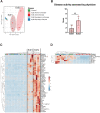Novel transcriptomic panel identifies histologically active eosinophilic oesophagitis
- PMID: 38670631
- PMCID: PMC11187384
- DOI: 10.1136/gutjnl-2023-331743
Novel transcriptomic panel identifies histologically active eosinophilic oesophagitis
Abstract
Background and aims: Eosinophilic oesophagitis (EoE) is characterised by symptoms of esophageal dysfunction and oesinophil tissue infiltration. The EoE Diagnostic Panel (EDP) can distinguish between active and non-active EoE using a set of 77 genes. Recently, the existence of distinct EoE variants featuring symptoms similar to EoE, such as oesophageal dysfunction but lacking eosinophil infiltration, had been determined.
Methods: We used oesophageal biopsies from patients with histologically active (n=10) and non-active EoE (n=9) as well as from healthy oesophageal controls (n=5) participating in the Swiss Eosinophilic Esophagitis Cohort Study (SEECS) and analysed the gene expression profile in these biopsies by total RNA-sequencing (RNA-seq). Moreover, we employed the publicly accessible RNA-seq dataset (series GSE148381) as reported by Greuter et al, encompassing a comprehensive genomic profile of patients presenting with EoE variants.
Results: A novel, diagnostic gene expression panel that can effectively distinguish patients with histologically active conventional EoE from patients with EoE in histological remission and control individuals, and from three newly discovered EoE variants was identified. Histologically Active EoE Diagnostic Panel (HAEDP) consists of 53 genes that were identified based on differential expression between histologically active EoE, histological remission and controls (p≤0.05). By combining the HAEDP with EDP, we expanded our knowledge about factors that may contribute to the inflammation in EoE and improved our understanding of the underlying mechanisms of the disease. Conversely, we suggested a compact group of genes common to both HAEDP and EDP to create a reliable diagnostic tool that might enhance the accuracy of EoE diagnosis.
Conclusion: We identified a novel set of 53 dysregulated genes that are closely associated with the histological inflammatory activity of EoE. In combination with EDP, our new panel might be a valuable tool for the accurate diagnosis of patients with EoE as well as for monitoring their disease course.
Keywords: oesophageal disease; oesophageal disorders; oesophagitis.
© Author(s) (or their employer(s)) 2024. Re-use permitted under CC BY-NC. No commercial re-use. See rights and permissions. Published by BMJ.
Conflict of interest statement
Competing interests: MS has shares and is a co-founder of Recolony, Zurich, and has shares in PharmaBiome, Zurich. MS served as advisor for AbbVie, Gilead, Fresenius, Topadur, Takeda, Roche and Celltrion. MS received speaker’s honoraria from Janssen, Falk Pharma, Vifor Pharma, Pileje and Bromatech. MS received research grants from AbbVie, Takeda, Gilead, Gnubiotics, Roche, Axalbion, Pharmabiome, Topadur, Basilea, MBiomics, Storm Therapeutics, LimmatTech, Zealand Pharma, NodThera, Calypso Biotech, Pileje, Herbodee, Vifor. ASc received speaker/advisor fees from AbbVie, AstraZeneca, Janssen, Receptos-Celgene-BMS, Dr Falk Pharma, GSK, MSD, Pfizer, Sanofi-Regeneron, Takeda and Vifor. ASc received research grants from AbbVie, AstraZeneca, Receptos-Celgene-BMS, Dr Falk Pharma, GSK, MSD, Pfizer, Sanofi-Regeneron and Vifor. ASt has consultant contracts with AstraZeneca, Receptos-Celene-BMS, Calypso, EsoCap, Dr Falk Pharma, GSK, Pfizer, Sanofi-Regeneron and Shire.
Figures





References
Publication types
MeSH terms
LinkOut - more resources
Full Text Sources
Medical
